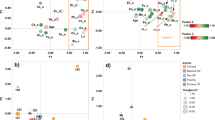Abstract
The measurement of urinary cobalt as an estimator of exposure to airborne cobalt was evaluated during the wet sharpening of hard metal and stellite blades. The following possible confounding factors were also studied: smoking habits, personal hygiene, cobalt absorption through the skin, beer drinking, and vitamin B12 consumption. The study was conducted in 16 different workplaces manufacturing or maintaining blades and in laboratory experiments. Cobalt contamination and its removal from workers’ hands were studied with different hand-washing methods, and cobalt from used gloves was also analyzed. The Finnish biomonitoring action level of 600 nmol/l (35.4 μg/l) was exceeded in 4 of the 16 workplaces, and the mean concentration of urinary cobalt was 241 (8–2705) nmol/l [14.2 (0.5–160) μg/l]. The coefficient of correlation between the cobalt concentrations in the air and in the workers’ urine was 0.753. The urinary cobalt concentration corresponding to the Finnish occupational exposure limit for airborne cobalt (0.05 mg/m3) was 686 nmol/l (40.5 μg/l). The level of personal hygiene affected the urinary cobalt concentrations, and cobalt was absorbed through the skin. Beer and vitamin B12 consumption did not have any effect on the urinary levels of cobalt. The workers who smoked had higher urinary concentrations of cobalt than the nonsmoking workers. High concentrations of cobalt in coolants contaminated the workers’ skin, and hand-washing did not remove cobalt very effectively. The results indicate that urinary cobalt can be used reliably to assess workers’ exposure to airborne cobalt when wet-tip grinding processes are used. The results also show that workers’ exposure to cobalt can be reduced by improving skin protection and personal hygiene in workplaces.
Similar content being viewed by others
Author information
Authors and Affiliations
Additional information
Received: 29 January 1996 / Accepted: 2 May 1996
Rights and permissions
About this article
Cite this article
Linnainmaa, M., Kiilunen, M. Urinary cobalt as a measure of exposure in the wet sharpening of hard metal and stellite blades. Int Arch Occup Environ Health 69, 193–200 (1997). https://doi.org/10.1007/s004200050136
Issue Date:
DOI: https://doi.org/10.1007/s004200050136




